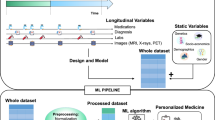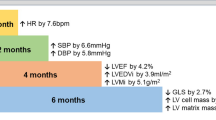Abstract
The objectives of this study were to introduce a new type of heart-rate variability analysis improving risk stratification in patients with idiopathic dilated cardiomyopathy (DCM) and to provide additional information about impaired heart beat generation in these patients. Beat-to-beat intervals (BBI) of 30-min ECGs recorded from 91 DCM patients and 21 healthy subjects were analyzed applying the lagged segmented Poincaré plot analysis (LSPPA) method. LSPPA includes the Poincaré plot reconstruction with lags of 1–100, rotating the cloud of points, its normalized segmentation adapted to their standard deviations, and finally, a frequency-dependent clustering. The lags were combined into eight different clusters representing specific frequency bands within 0.012–1.153 Hz. Statistical differences between low- and high-risk DCM could be found within the clusters II–VIII (e.g., cluster IV: 0.033–0.038 Hz; p = 0.0002; sensitivity = 85.7 %; specificity = 71.4 %). The multivariate statistics led to a sensitivity of 92.9 %, specificity of 85.7 % and an area under the curve of 92.1 % discriminating these patient groups. We introduced the LSPPA method to investigate time correlations in BBI time series. We found that LSPPA contributes considerably to risk stratification in DCM and yields the highest discriminant power in the low and very low-frequency bands.


Similar content being viewed by others
References
Babloyantz A, Destexhe A (1988) Is the normal heart a periodic oscillator? Biol Cybern 58(3):203–211
Baumert M, Walther T, Hopfe J, Stepan H, Faber R, Voss A (2002) Joint symbolic dynamic analysis of beat-to-beat interactions of heart rate and systolic blood pressure in normal pregnancy. Med Biol Eng Comput 40(2):241–245
Bernjak A, Clarkson PB, McClintock PV, Stefanovska A (2008) Low-frequency blood flow oscillations in congestive heart failure and after beta1-blockade treatment. Microvasc Res 76(3):224–232
Brennan M, Palaniswami M, Kamen P (2002) Poincare plot interpretation using a physiological model of hrv based on a network of oscillators. Am J Physiol Heart Circ Physiol 283(5):H1873–H1886
Golenhofen K (1970) Slow rhythms in smooth muscle. Edward Arnold Ltd., London, pp 316–342
Grimm W, Maisch B (2002) Sudden cardiac death in dilated cardiomyopathy: therapeutic options. Herz 27(8):750–759
Grimm W, Christ M, Bach J, Muller HH, Maisch B (2003) Noninvasive arrhythmia risk stratification in idiopathic dilated cardiomyopathy: results of the Marburg cardiomyopathy study. Circulation 108(23):2883–2891
Guzik P, Piskorski J, Krauze T, Wykretowicz A, Wysocki H (2006) Heart rate asymmetry by Poincare plots of rr intervals. Biomed Tech (Berl) 51(4):272–275
Hoyer D, Leder U, Hoyer H, Pompe B, Sommer M, Zwiener U (2002) Mutual information and phase dependencies: measures of reduced nonlinear cardiorespiratory interactions after myocardial infarction. Med Eng Phys 24(1):33–43
Hoyer D, Pompe B, Chon KH, Hardraht H, Wicher C, Zwiener U (2005) Mutual information function assesses autonomic information flow of heart rate dynamics at different time scales. IEEE Trans Biomed Eng 52(4):584–592
Kaiser L, Spickard RC, Olivier NB (1989) Heart failure depresses endothelium-dependent responses in canine femoral artery. Am J Physiol 256(4 Pt 2):H962–H967
Kamen PW, Tonkin AM (1995) Application of the Poincare plot to heart rate variability: a new measure of functional status in heart failure. Aust N Z J Med 25(1):18–26
Kuusela TA, Kaila TJ, Kahonen M (2003) Fine structure of the low-frequency spectra of heart rate and blood pressure. BMC Physiol 3:11
Lerma C, Infante O, Perez-Grovas H, Jose MV (2003) Poincare plot indexes of heart rate variability capture dynamic adaptations after haemodialysis in chronic renal failure patients. Clin Physiol Funct Imaging 23(2):72–80
Malberg H, Wessel N, Hasart A, Osterziel KJ, Voss A (2002) Advanced analysis of spontaneous baroreflex sensitivity, blood pressure and heart rate variability in patients with dilated cardiomyopathy. Clin Sci (Lond) 102(4):465–473
Moe-Nilssen R, Helbostad JL (2004) Estimation of gait cycle characteristics by trunk accelerometry. J Biomech 37(1):121–126
Pichon A, Roulaud M, Antoine-Jonville S, Bisschop CD, Denjean A (2005) Spectral analysis of heart rate variability: interchangeability between autoregressive analysis and fast Fourier transform. J Electrocardiol 39(1):31–37
Piskorski J, Guzik P (2005) Filtering Poincaré plots. Comput Method Sci Technol 11(1):39–48
Piskorski J, Guzik P (2007) Geometry of the Poincare plot of rr intervals and its asymmetry in healthy adults. Physiol Meas 28(3):287–300
Priori SG, Aliot E, Blomstrom-Lundqvist C, Bossaert L, Breithardt G, Brugada P, Camm AJ, Cappato R, Cobbe SM, Di Mario C, Maron BJ, McKenna WJ, Pedersen AK, Ravens U, Schwartz PJ, Trusz-Gluza M, Vardas P, Wellens HJ, Zipes DP (2001) Task force on sudden cardiac death of the European Society of Cardiology. Eur Heart J 22(16):1374–1450
Przibille O, Liebrich A, Nowak B, Rosocha S, Zellerhoff CH, Geil S, Himmrich E, Treese N, Meyer J (1998) Prognostic significance of analysis of heart rate variability inpatients with dilated cardiomyopathy. Z Kardiol 87(6):453–458
Richardson P, McKenna W, Bristow M, Maisch B, Mautner B, O’Connell J, Olsen E, Thiene G, Goodwin J, Gyarfas I, Martin I, Nordet P (1996) Report of the 1995 world health organization/international society and federation of cardiology task force on the definition and classification of cardiomyopathies. Circulation 93(5):841–842
Rossi M, Carpi A, Di Maria C, Franzoni F, Galetta F, Santoro G (2007) Post-ischaemic peak flow and myogenic flowmotion component are independent variables for skin post-ischaemic reactive hyperaemia in healthy subjects. Microvasc Res 74(1):9–14
Schirdewahn P, Dorszewski A, Hindricks G, Kobza R, Kottkamp H, Tanner H (2004) Plötzlicher herztod und icd-therapie. J für Kardiologie 11
Task Force of the Europe Society of Cardiology and the North American Society of Pacing and Electrophysiology (1996) Heart rate variability: standards of measurement, physiological interpretation and clinical use. Circulation 93(5):1043–1065
Taylor MR, Carniel E, Mestroni L (2006) Cardiomyopathy, familial dilated. Orphanet J Rare Dis 1:27
Thakre TP, Smith ML (2006) Loss of lag-response curvilinearity of indices of heart rate variability in congestive heart failure. BMC Cardiovasc Disord 6:27
Tikhonova IV, Tankanag AV, Chemeris NK (2010) Time-amplitude analysis of skin blood flow oscillations during the post-occlusive reactive hyperemia in human. Microvasc Res 80(1):58–64
Treasure CB, Vita JA, Cox DA, Fish RD, Gordon JB, Mudge GH, Colucci WS, Sutton MG, Selwyn AP, Alexander RW et al (1990) Endothelium-dependent dilation of the coronary microvasculature is impaired in dilated cardiomyopathy. Circulation 81(3):772–779
Voss A, Kurths J, Kleiner HJ, Witt A, Wessel N, Saparin P, Osterziel KJ, Schurath R, Dietz R (1996) The application of methods of non-linear dynamics for the improved and predictive recognition of patients threatened by sudden cardiac death. Cardiovasc Res 31(3):419–433
Voss A, Schroeder R, Truebner S, Goernig M, Figulla HR, Schirdewan A (2007) Comparison of nonlinear methods symbolic dynamics, detrended fluctuation, and Poincare plot analysis in risk stratification in patients with dilated cardiomyopathy. Chaos 17(1):015120–015127
Voss A, Fischer C, Schroeder R, Figulla HR, Goernig M (2010) Segmented Poincare plot analysis for risk stratification in patients with dilated cardiomyopathy. Methods Inf Med 49(5):511–515
Wessel N, Voss A, Malberg H, Ziehmann C, Voss HU, Schirdewan A, Meyerfeldt U, Kurths J (2000) Nonlinear analysis of complex phenomena in cardiological data. Herzschr Elektrophys 11:159–173
Acknowledgments
The authors wish to gratefully acknowledge the financial support provided by the Deutsche Forschungsgemeinschaft (DFG: Vo 505/8-1 and Vo 505/8-2).
Author information
Authors and Affiliations
Corresponding author
Rights and permissions
About this article
Cite this article
Voss, A., Fischer, C., Schroeder, R. et al. Lagged segmented Poincaré plot analysis for risk stratification in patients with dilated cardiomyopathy. Med Biol Eng Comput 50, 727–736 (2012). https://doi.org/10.1007/s11517-012-0925-5
Received:
Accepted:
Published:
Issue Date:
DOI: https://doi.org/10.1007/s11517-012-0925-5




